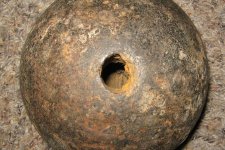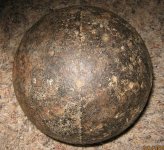Hello
Can anyone ID this as being an actual CW cannon ball and if so is it north or south? Any assistance would be great.
It measure 5 1/2" and weighs 16 lbs 5 1/2 oz. It also has what looks like a fuse hole. It was reportedly dug in PA.
Steve
Can anyone ID this as being an actual CW cannon ball and if so is it north or south? Any assistance would be great.
It measure 5 1/2" and weighs 16 lbs 5 1/2 oz. It also has what looks like a fuse hole. It was reportedly dug in PA.
Steve











